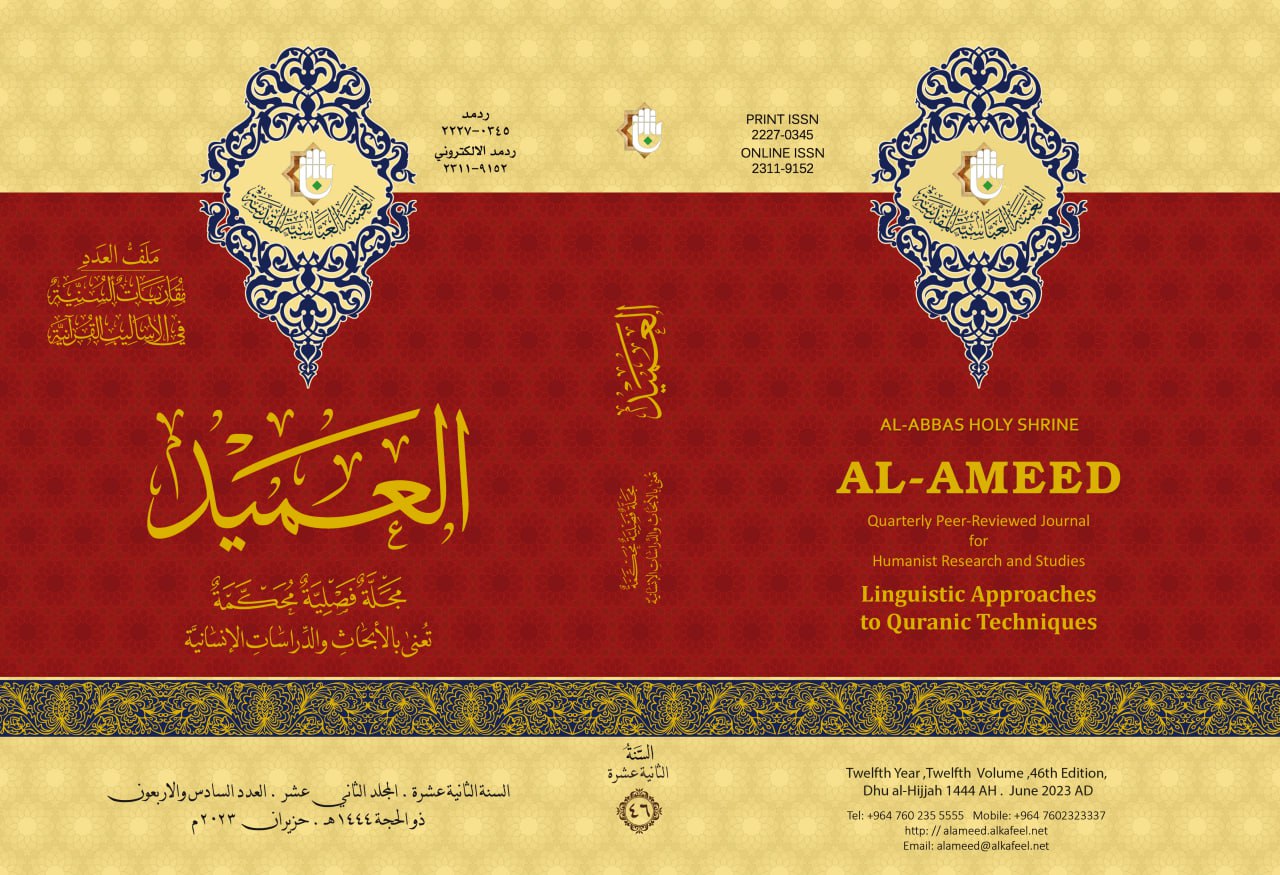Abstract
The Quranic expression was distinguished by the eloquence
of its structures and the abundance of its meanings;
perceiving subtle meanings and solemn purposes without ambiguity.
The balance between its composition and the possible
alternatives leads us to the strengths of the style and the
sublime meaning. The interpreters try to trace the Quranic
structures that stand behind each expression. One of them is
"the technique of repelling illusion" as the Quranic composition
intends to repel the corrupt meaning that may come to
mind by means of a linguistic technique. So the noble system
comes in a way that prevents this corrupt meaning from being
represented in the mind from the first sight.
The eluded meaning: It is a corrupt meaning that may occur
in the mind of the recipient at first sight without looking at the
clues that reveal the intended meaning. It is a rejected meaning
that may not need a synthetic presumption that sometimes
prevents it, as we find in many corrupt meanings whose corruption
is inferred by verbal and contextual evidences.
It is noticed that Aba Al-Saud takes a great care in tracing
these techniques and their impact on the Quranic structure,
so he was one of the interpreters who pay attention to such an
angle. Abi Al-Saud brought a set of linguistic means to refute
the illusion of meaning through: inversion, repetition, objection,
being explicit when it should be implicit and vice versa,
restriction, indefinitization, singularization and pluralization.
of its structures and the abundance of its meanings;
perceiving subtle meanings and solemn purposes without ambiguity.
The balance between its composition and the possible
alternatives leads us to the strengths of the style and the
sublime meaning. The interpreters try to trace the Quranic
structures that stand behind each expression. One of them is
"the technique of repelling illusion" as the Quranic composition
intends to repel the corrupt meaning that may come to
mind by means of a linguistic technique. So the noble system
comes in a way that prevents this corrupt meaning from being
represented in the mind from the first sight.
The eluded meaning: It is a corrupt meaning that may occur
in the mind of the recipient at first sight without looking at the
clues that reveal the intended meaning. It is a rejected meaning
that may not need a synthetic presumption that sometimes
prevents it, as we find in many corrupt meanings whose corruption
is inferred by verbal and contextual evidences.
It is noticed that Aba Al-Saud takes a great care in tracing
these techniques and their impact on the Quranic structure,
so he was one of the interpreters who pay attention to such an
angle. Abi Al-Saud brought a set of linguistic means to refute
the illusion of meaning through: inversion, repetition, objection,
being explicit when it should be implicit and vice versa,
restriction, indefinitization, singularization and pluralization.
Keywords
eluded meaning
guidance of the sound mind of Abu Al-Saud.
precaution against eluding meaning
Abstract
انماز التعبير القرآني بفصاحة تراكيبه وجزالة معانيه؛ استيفاء للمعاني الدقيقة
والمقاصد الجليلة بلا غموض. والموازنة بين تركيبه وبين البدائل الممكنة توصلنا
إلى مكامن قوة الأسلوب وسمو المعنى، وقد حاول المفسرون تصيّد علل التعبير
القرآني التي تقف وراء كل تعبير. ومن هذه العلل )علة دفع التوهم(، ويقصد بها
أن يعمد التركيب القرآني إلى دفع ما قد يتبادر إلى الذهن من معنى فاسد متوسلا
بوسيلة لغوية تحرز للنص الكريم طروء هذا المعنى في الذهن. فيأتي النظم الكريم
على نحو يمنع تمثُّل هذا المعنى الفاسد في الذهن من اول وهلة.
والمعنى المتوهم: هو معنى فاسد قد يطرأ في ذهن المتلقي لأول وهلة من
دون النظر في القرائن التي تكشف المعنى المراد، فهو معنى مرفوض ممتنع قد لا
يحتاج إلى قرينة تركيبية أحيانا تحول دونه كما نجد في كثير من المعاني الفاسدة
التي يستدل على فسادها بقرائن مقالية ومقامية، ولكن في المواضع التي نحن
بصددها تكفل التركيب بدفع ذلك الوهم وردِّ تبادره إلى الذهن، بما جاد به من
مؤشرات اسلوبية تعصم الذهن من المعنى المتخيل السقيم.
وقد لحظت أن أبا السعود قد عُني عناية كبيرة برصد هذه العلة وأثرها في
اختيار التركيب القرآني، فكان من أكثر المفسرين التفاتا إلى ذلك، وقد حرصت
في هذا البحث على تتبع هذه العلة، وتبيان الوسائل التي توخاها القرآن الكريم
لدفع المعنى المتوهم. وقد تحصل لديَّ من استقراء ما جاء به تفسير أبي السعود
مجموعة من الوسائل اللغوية نصل بها إلى دفع توهم المعنى، وتتمثل بما يأتي:
التقديم والتأخير، التكرار، الاعتراض، الإظهار في موضع الإضمار، التقييد،
التنكير، الإفراد والجمع.
والمقاصد الجليلة بلا غموض. والموازنة بين تركيبه وبين البدائل الممكنة توصلنا
إلى مكامن قوة الأسلوب وسمو المعنى، وقد حاول المفسرون تصيّد علل التعبير
القرآني التي تقف وراء كل تعبير. ومن هذه العلل )علة دفع التوهم(، ويقصد بها
أن يعمد التركيب القرآني إلى دفع ما قد يتبادر إلى الذهن من معنى فاسد متوسلا
بوسيلة لغوية تحرز للنص الكريم طروء هذا المعنى في الذهن. فيأتي النظم الكريم
على نحو يمنع تمثُّل هذا المعنى الفاسد في الذهن من اول وهلة.
والمعنى المتوهم: هو معنى فاسد قد يطرأ في ذهن المتلقي لأول وهلة من
دون النظر في القرائن التي تكشف المعنى المراد، فهو معنى مرفوض ممتنع قد لا
يحتاج إلى قرينة تركيبية أحيانا تحول دونه كما نجد في كثير من المعاني الفاسدة
التي يستدل على فسادها بقرائن مقالية ومقامية، ولكن في المواضع التي نحن
بصددها تكفل التركيب بدفع ذلك الوهم وردِّ تبادره إلى الذهن، بما جاد به من
مؤشرات اسلوبية تعصم الذهن من المعنى المتخيل السقيم.
وقد لحظت أن أبا السعود قد عُني عناية كبيرة برصد هذه العلة وأثرها في
اختيار التركيب القرآني، فكان من أكثر المفسرين التفاتا إلى ذلك، وقد حرصت
في هذا البحث على تتبع هذه العلة، وتبيان الوسائل التي توخاها القرآن الكريم
لدفع المعنى المتوهم. وقد تحصل لديَّ من استقراء ما جاء به تفسير أبي السعود
مجموعة من الوسائل اللغوية نصل بها إلى دفع توهم المعنى، وتتمثل بما يأتي:
التقديم والتأخير، التكرار، الاعتراض، الإظهار في موضع الإضمار، التقييد،
التنكير، الإفراد والجمع.
Keywords
الاحتراز عن توهم المعنى، المعنى المتوهم، إرشاد العقل السليم لأبي السعود.
